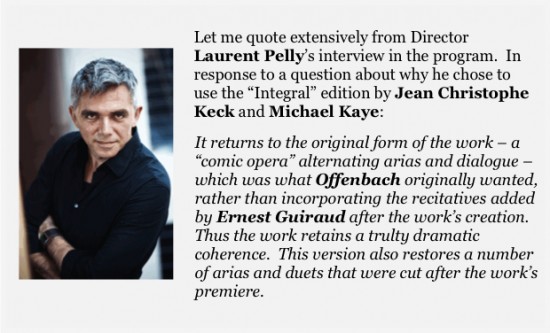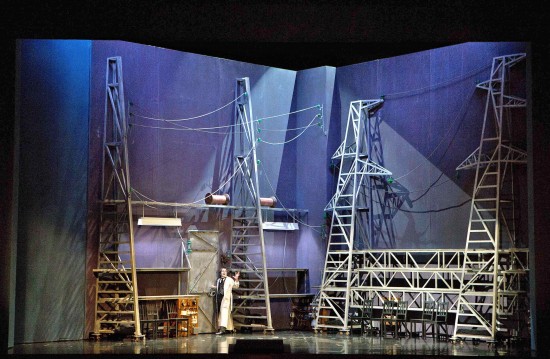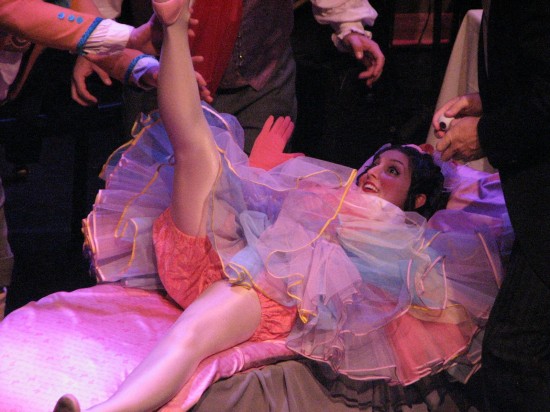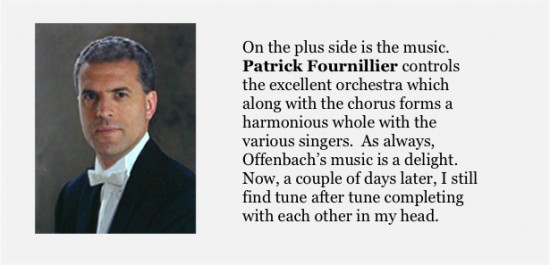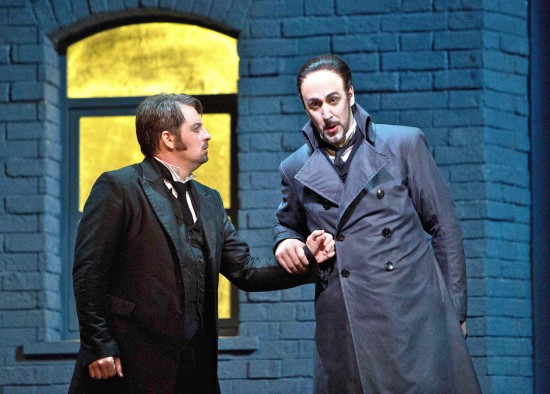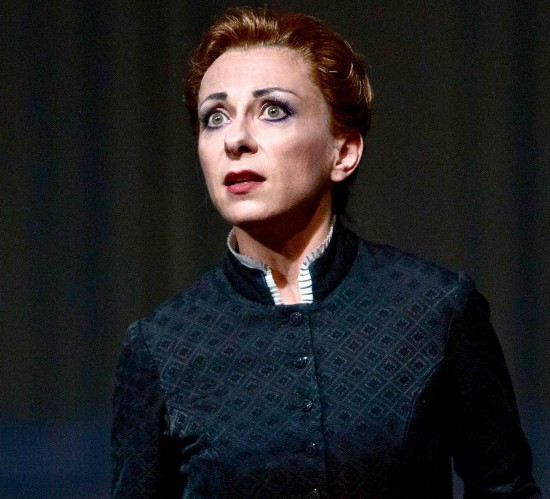This is the seventh performance and the fourth different production of Tales of Hoffmann that I have seen during just the past year – and by far the most different. Since I have already written three reviews, I don’t want to repeat myself by talking about the plot. If you are not already familiar with the plot of a classic production, you may want to read my review of the Pocket Opera production before proceeding with this review.
One of the fascinating things about opera is the extent to which one production can differ from another. This is particularly true of Tales of Hoffmann because Offenbach died before he completely finished composing it. At the time of his death there existed various versions of some of the scenes, and it was not always obvious which one Jacques Offenbach intended to use in the final production, nor exactly how they would be stitched together. As a result, a director can choose among almost infinite combinations and no one can say that he is “wrong”.
And, in response to a question as to what was the inspiration for incorporating the painting style of Leon Spilliaert into the design:
[It was] immediately obvious to me. A realistic fantasy and mystery with everyday life can be found in the painter’s work of his central period as with Hoffmann’s works. All of Spilliaert’s work seems to show a banal interior, animated by a disturbing magic. Through the eyes of the artist, every piece of furniture, each colored wall takes the viewer into a deep and mysterious realm, transforming reality into something strange and surreal. It’s a traditional environment inhabited by shadows and secrets. . . .
[We have created] a space that comes from the imagination of the poet. A world both real and dreamlike, and a device that moves us from one story to another.
How well does all this work? As the pre-opera lecturer Marcia Green said several times, “It’s up to you (the audience) to decide.” As a member of the audience in seat R1, my answer is, “Too well!” The staging, lighting, and blocking are all filled with unrelated sequences, harsh edges, and unpredictable movements – as are dreams. But if it’s all a dream, who is the dreamer? It’s certainly not my dream. Hoffmann’s? Possibly, but if so what is the point since we know absolutely nothing about Hoffmann, the dreamer? No, it can only be Pelly’s dream or, by a stretch of the imagination, Offenbach’s dream.
I’ve harped on this theme before, but an opera has a story to tell. It should use all of its resources, orchestra, singing, acting, words, costumes, staging effects to immerse all of the audience’s senses in that story. All of the elements should be subservient to the whole. All too often a director becomes too enamored of a particular gimmick in the staging. At its worst, the staging contradicts the story told by the other elements. Pelly is not guilty of that, but he is frequently distracting, and of a more subtle effect. Time devoted to showing off the gimmickry becomes unavailable for more conventional positive actions.
All of which is clearly demonstrated in Act II, Olympia. Spalanzani’s (Thomas Glenn’s) laboratory is impressive, although I don’t see the connection with making life-like robots.
Olympia (Hye Jung Lee) gets introduced and goes into her song and dance. Lee’s singing is superb, and her dance is, shall we say, “different”. No twirling or turning, but lots of seemingly magical levitation. Quite effective and totally in synch with the music. [I regret that no examples of it were included the collection of press pictures].
But later in the scene her encounters with Hoffmann (Matthew Polenzani) are minimal, which is too bad. She shows none of the fantastic acting ability shown by Chelsea Hollow of Pocket Opera when she topples over from a sitting position making none of the natural leg motions that a human would make. Part of the reason is that the replacement of recitatives by the more efficient dialogues means that less stage time is available for acting.
One more thought before I leave all this negativism. The subject of opera in English is one over which otherwise reasonable opera lovers almost come to blows. The big argument in favor is that the American audience will better understand the story. On the con side, the original music was written for the French words with their natural pronunciation and stress. Replacing them by a literal translation creates gross disharmony. Replacing them by English words that fit the music and still convey the original meaning requires a “translator” who is a master poet and a skilled musician. BUT. None of those arguments applies to spoken dialogue. I see no excuse for not doing the dialogue in English. To the argument that it would not be “authentic”, I recall Tom Lehrer’s comment about certain folksingers who “Confuse authenticity with merit.” I come to see a live opera – not a museum piece.
Both of the principal male singers were outstanding. Matthew Polenzani (Hoffmann) is a rising star in the opera world. I had seen him before on Met HD, but this was the first time I had heard him live. His rich tenor voice filled the War Memorial Auditorium from the start and continued strong through all 5 acts.
Christian Van Horn sang all four of the Satan roles. His name was familiar to me at SFOpera, but his previous roles had all be relatively minor parts: the Bonze (Madama Butterfly), Timur (Turandot), and Angelotti (Tosca). His makeup and his full booming bass voice did full justice to this major role (or roles). I hope to see more of him in future SFOpera productions.
Normally, one would list the soprano role of Hoffmann’s loves as the chief female lead. But here, as in most modern productions, a different soprano sings each of his four loves, which, from a star viewpoint dilutes the role. Therefore, I award that distinction to Angela Brower for her portrayal of Nicklausse and The Muse. And well she deserves it. Her mezzo voice was true and clear and well up to the demands of a large theater.
So how about those soprano loves of Hoffmann? I’ve already mentioned what a fine voice Hye Jung Lee had as Olympia, but I’ve been saving the best for last. Natalie Dessay sang the title role in my first Met HD performance, Daughter of the Regiment, and I’ve been in love with her ever since. As Antonia, she had little opportunity to show off the acting ability that handled such diverse roles as the afore-mentioned tomboy to the mad Lucia to the girl-queen Cleopatra, but her singing left me limp. She was particularly brilliant in the pianissimo passages. Scarcely more than a whisper, but by some magic it filled the vast auditorium.
Still lots of chances to see it: June 20, 23m, 27, and 30m, and July 3, and 6; matinee (m) shows at 2, evenings at 7:30 except Sat July 6 at 8.
San Francisco Opera
301 Van Ness Avenue
San Francisco, CA 94102
(415) 861-4008
webmaster@sfopera.com
Head shots from the SFOpera web site; except as noted, all action photos by Cory Weaver, San Francisco Opera
This review by Philip G Hodge appeared in sanfranciscosplash.com on June 17, 2013.

